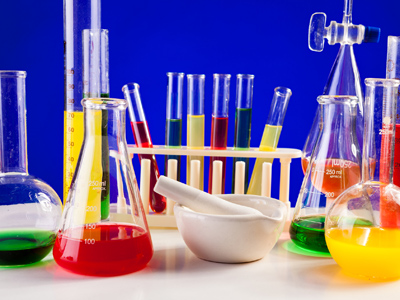
Find out how much you know about acid reactions in this quiz
Chemistry - Acid Reactions (AQA)
This Science quiz will test you on acid reactions. Acids are chemicals which readily release hydrogen ions into solution. This property makes them react in predictable ways with other substances, in particular metals and bases.
At GCSE level you need to know what will be made when hydrochloric or sulfuric acid react with a metal, and when hydrochloric, sulfuric or nitric acid are neutralised by a base. A base is any substance that will neutralise an acid, and an alkali is simply a soluble base.
1 .
What acid would I need to react with iron in order to make iron chloride?
Hydrochloric
Sulfuric
Nitric
Ethanoic
Iron chloride is a salt. A salt is a chemical made when the hydrogen in an acid is replaced by a metal. The formula for hydrochloric acid is HCl. If you replace the hydrogen with iron you are left with a compound made from iron and chlorine – iron chloride!
2 .
What are the products of the reaction between any acid and any metal carbonate?
Salt
Salt + water
Salt + hydrogen
Salt + water + carbon dioxide
The clue here is in the name CARBONate. Carbonates are bases, so a neutralisation reaction will occur, making a salt and water, but the carbon from the carbonate has to end up somewhere, so it turns into CO2 gas. These reactions always fizz
3 .
What are the products of the reaction between any acid and a metal?
Salt
Salt + water
Salt + hydrogen
Salt + water + carbon dioxide
Remember that a salt is made when the hydrogen in an acid is replaced by a metal. So acid + metal reactions are really just a special case of a displacement reaction. The metal pushes the hydrogen out of solution, so these reactions fizz
4 .
What are the products of the reaction between nitric acid and magnesium oxide?
Magnesium hydroxide + hydrogen
Magnesium nitride + water
Magnesium nitrate + water
Magnesium nitrate + hydrogen
This is a neutralisation reaction between an acid and a base, so the products will be a salt and water. Nitric acid has the formula HNO3, so the salt will contain the NO3- ion. Since oxygen as well as nitrogen is present in this product, the name will end –ate not –ide
5 .
What is used to test for hydrogen gas?
Lit splint
Glowing splint
Limewater
Damp blue litmus paper
Hydrogen is highly flammable, so we test for it by setting fire to it. The distinctive pop sound of the explosion indicates the presence of hydrogen
6 .
What is a positive test for carbon dioxide?
A squeaky pop
A glowing splint relights
Limewater turns milky
Damp blue litmus paper turns red and then bleaches
Carbon dioxide will extinguish a flame, but so will other gases, so testing for flammability is not a specific test for CO2. When it is bubbled through limewater a precipitate of calcium carbonate (chalk) is made which turns the clear solution cloudy or milky
7 .
Which is the correct formula for sulfuric acid?
HSO4
H2SO4
H2S
H2SO3
I think the best way of remembering this is by using a poem:
Johnny was a scientist, Johnny is no more
For what he thought was H2O was H2SO4
Johnny was a scientist, Johnny is no more
For what he thought was H2O was H2SO4
8 .
Which of these substances is a base?
Magnesium chloride
Magnesium sulfate
Magnesium nitrate
Magnesium oxide
Chlorides, sulfates and nitrates are all salts, made by replacing the hydrogen in, respectively hydrochloric acid, sulfuric acid and nitric acid. The oxygen in magnesium oxide will join up with the hydrogen from the acid to make water; oxides are bases as are hydroxides and carbonates
9 .
Which reactants would you choose if you wanted to make copper sulfate?
Copper oxide and sulfuric acid
Copper chloride and sulfuric acid
Copper and sulfuric acid
Copper nitrate and sulfuric acid
Copper sulfate needs to be made by a neutralisation reaction. Copper metal is too unreactive to react with an acid directly, so either copper oxide or copper carbonate would have to be used
10 .
Which of the following shows what happens to a magnesium atom when it reacts with an acid?
Mg + e- → Mg-
Mg → Mg+ + e-
Mg + 2 e- → Mg2-
Mg → Mg2+ + 2 e-
Metal atoms always lose electrons when they react, becoming positive ions. Magnesium is in group 2 of the periodic table, so it has two electrons in its outer shell and therefore will lose both of them to become a 2+ ion. We say that the magnesium has been oxidised, because oxidation is loss of electrons
**Unlimited Quizzes Await You! 🚀**
Hey there, quiz champ! 🌟 You've already tackled today's free questions.
Ready for more?
Ready for more?
🔓 Unlock UNLIMITED Quizzes and challenge yourself every day. But that's
not all...
not all...
🔥 As a Subscriber you can join our thrilling "Daily Streak" against other
quizzers. Try to win a coveted spot on our Hall of Fame Page.
quizzers. Try to win a coveted spot on our Hall of Fame Page.
Don't miss out! Join us now and keep the fun rolling. 🎉
**Unlimited Quizzes Await You! 🚀**
Hey there, quiz champ! 🌟 You've already tackled today's free questions. Ready for more?
🔓 Unlock UNLIMITED Quizzes and challenge yourself every day. But that's not all...
🔥 As a Subscriber you can join our thrilling "Daily Streak" against other quizzers. Try to win a coveted spot on our Hall of Fame Page.
Don't miss out! Join us now and keep the fun rolling. 🎉







